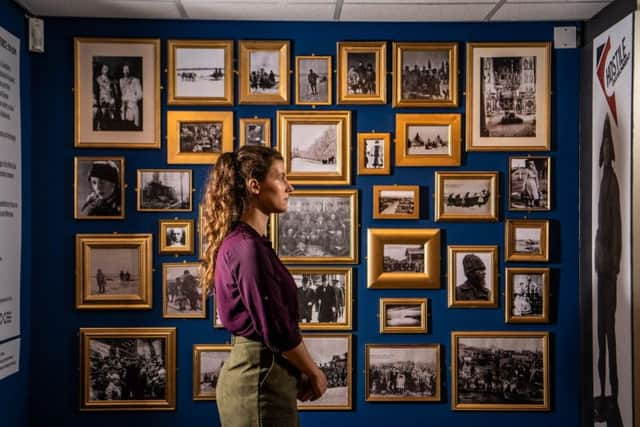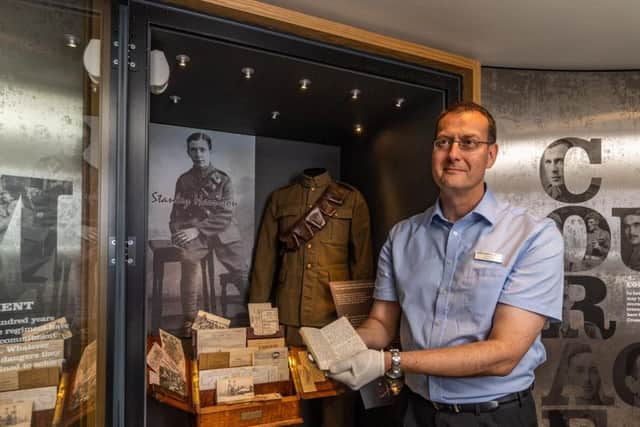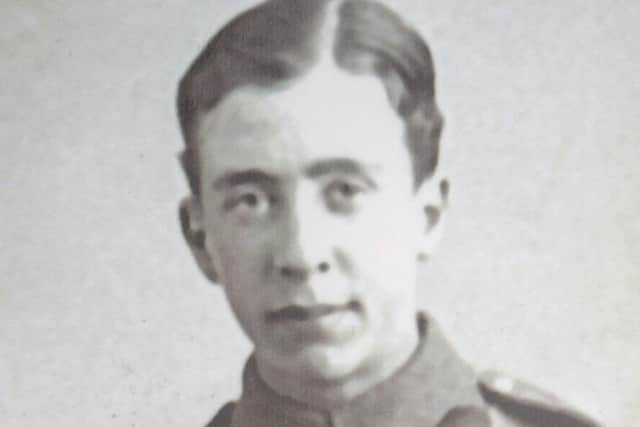The Yorkshire soldiers that intervened in the Russian civil war
The Armistice of November 11, 1918, marked the end of the First World War. But for Fred Neesam, a former linen weaver from Northallerton, and Samuel Staite, a self-employed house-painter from Leeds, the fighting was far from over.
Along with 1,300 other men of the 6th and 13th battalions of the Yorkshire Regiment (the Green Howards), they were on board a ship heading for the frozen north of Russia.
Advertisement
Hide AdAdvertisement
Hide AdFrom June 1918 until October 1919, Allied forces – principally Britain, the United States and France – intervened in the Russian civil war, fighting with the White Army against the Bolsheviks.


This neglected bit of history has now been brought vividly to life in a superb exhibition at The Green Howards Museum in Richmond.
The story of Britain’s fishermen and the crucial yet often undervalued role they played during the First World WarAt Catterick, the men were issued with Lee Enfield rifles and kitted out with fur hats, fur-lined, floor-length greatcoats and snow boots based on those worn by Antarctic explorer Ernest Shackleton.
On October 15, they mustered on board ship in Dundee, but with the war nearing its end, there was little enthusiasm for this Russian venture. Officers were allowed ashore, but the men were not. The result was a mutiny: 300 men rushed the gangway and went ashore.
Advertisement
Hide AdAdvertisement
Hide AdThe diary of a teenager from Nottingham, Private Stanley Harrison – one of the museum’s star exhibits – records what happened: “All men upon decks cheering, shouting and booing.


"Men (of which I was one) played havoc with Brig. Gen, CO and officers and sang ‘Tell me the old, old story’ in response to promises… things returned to normal about 8pm… Good old Green Howards stick it. Brig. Gen could not answer many of the pertinent questions put to him. Gee, I am seeing life.”
“We’re so lucky to have this diary,” says the museum’s Fiona Hall. “It’s as if Stanley Harrison has been waiting patiently for 100 years to tell the story”.
Story of the Home Front in Craven during The First World War told in new exhibitionSo why were the Green Howards sent to Russia? The ostensible reason was to guard 600,000 tonnes of munitions at Murmansk and Arkhangelsk which the Western allies had supplied to Russia – to prevent these falling into the hands initially of Germany and then, following the cessation of hostilities between Germany and Russia, of the Bolsheviks.
Advertisement
Hide AdAdvertisement
Hide AdBut with Russian trade becoming increasingly important for Britain, there were economic, commercial and political reasons for supporting the counter-revolutionary forces of the White Army. Winston Churchill, then Secretary of State for War, said that he wanted “to strangle at birth the Bolshevik State”.


Soon after leaving Dundee the ship developed a list, the boiler burst, and the vessel was towed into a bay in the Shetlands. A voyage that should have taken six days ended up taking six weeks.
On November 28, the Green Howards disembarked at Murmansk, where they faced sub-zero temperatures and just three hours of daylight. They found themselves fighting alongside the White Army in skirmishes against the Bolsheviks. It was guerrilla warfare in the most hostile environment imaginable.
Stanley Harrison’s diary gives us a compelling description of the conditions the men faced – and of the mood they were in: “Jan 4th. Bitterly cold, especially working outdoors … Shackleton says we are well equipped and fit to stand a winter here. Would like to interview him and expose things.
Advertisement
Hide AdAdvertisement
Hide Ad“Jan 12th Gen Maynard’s message to Allied Troops read out. All absolute rot … Says we may be here until 1920 and refers to ‘playing the game’. He ought to come round here and have a talk with me… Everyone regards it as an absolute farce. The coldest day since we have been here. 14 degrees below zero.”
In February, there was a second mutiny. As at Dundee, there were court martials and punishments, but the sentences were later reduced. These, like some 70 other mutinies that took place in the British Army in 1919, were hushed up. The War Cabinet recommended the evacuation of Arkhangelsk; but it was September 1919 before the last Green Howards were back in Britain.
In March that year the Green Howards fought with White Russian forces against partisan regiments of the Red Army at the village of Bolshie Ozerki. This battle, the last engagement to involve British forces, accounted for many of the Green Howards’ 27 fatalities.
How Wakefield women helped First World War effort on home front and abroadSix months later (October 15, 1919), The Yorkshire Post carried a report of the engagement under the heading “Abortive Attack on a Bolshevik Village”.
Advertisement
Hide AdAdvertisement
Hide AdOne of the museum’s prize exhibits (donated by his granddaughters) are the snow goggles worn by Samuel Staite. Another is the recording of an interview with Company Sergeant Major Fred Neesam, an experienced soldier who had fought in France and Belgium. Neesam was one of three British soldiers who travelled with Cossacks on reindeer-pulled sleds from Arkhangelsk to Omsk and then on to Ekaterinburg – a distance of more than 2,000 miles – to deliver papers to Admiral Kolchak of the Imperial Russian Navy. Neesam talks about temperatures of minus 50 degrees, the dangers of frostbite, and the difficulty of sustaining reindeer when their natural food, lichens, is inaccessible.
A 15-minute film shows how the soldiers were trained to walk and fight on skis. It also includes footage of Cossacks showing off their horsemanship, and off-duty British soldiers skating and sliding.
The exhibition, a fitting tribute to the Yorkshiremen and other Green Howards who took part in the North Russia Intervention, was opened by Princess Olga Romanoff, a descendant of the last Russian Tsar.
There is a longstanding connection between Yorkshire and the Russian royal family. In 1894, the future Tsarina, Queen Victoria’s granddaughter Alexandra, visited Harrogate; she stayed at Cathcart House (a leading boarding house), became godmother to the owner’s new-born twins, and lavished them with gifts for the rest of her life.
Advertisement
Hide AdAdvertisement
Hide AdToday, the North Russia Intervention – an Allied invasion that ended in defeat and withdrawal – is barely remembered in Russia. But one memento remains on display in Arkhangelsk– a British Mark V tank, captured by the Red Army.
Hostile Environment, a special exhibition at The Green Howards Museum, Richmond, continues until December 14. For details visit greenhowards.org.uk to find out more.